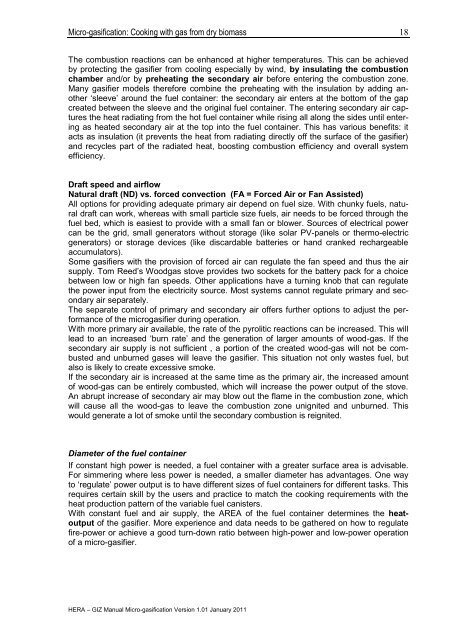Micro-gasification: Cooking with gas from biomass - Amper
Micro-gasification: Cooking with gas from biomass - Amper
Micro-gasification: Cooking with gas from biomass - Amper
Create successful ePaper yourself
Turn your PDF publications into a flip-book with our unique Google optimized e-Paper software.
<strong>Micro</strong>-<strong><strong>gas</strong>ification</strong>: <strong>Cooking</strong> <strong>with</strong> <strong>gas</strong> <strong>from</strong> dry <strong>biomass</strong><br />
The combustion reactions can be enhanced at higher temperatures. This can be achieved<br />
by protecting the <strong>gas</strong>ifier <strong>from</strong> cooling especially by wind, by insulating the combustion<br />
chamber and/or by preheating the secondary air before entering the combustion zone.<br />
Many <strong>gas</strong>ifier models therefore combine the preheating <strong>with</strong> the insulation by adding another<br />
‗sleeve‘ around the fuel container: the secondary air enters at the bottom of the gap<br />
created between the sleeve and the original fuel container. The entering secondary air captures<br />
the heat radiating <strong>from</strong> the hot fuel container while rising all along the sides until entering<br />
as heated secondary air at the top into the fuel container. This has various benefits: it<br />
acts as insulation (it prevents the heat <strong>from</strong> radiating directly off the surface of the <strong>gas</strong>ifier)<br />
and recycles part of the radiated heat, boosting combustion efficiency and overall system<br />
efficiency.<br />
Draft speed and airflow<br />
Natural draft (ND) vs. forced convection (FA = Forced Air or Fan Assisted)<br />
All options for providing adequate primary air depend on fuel size. With chunky fuels, natural<br />
draft can work, whereas <strong>with</strong> small particle size fuels, air needs to be forced through the<br />
fuel bed, which is easiest to provide <strong>with</strong> a small fan or blower. Sources of electrical power<br />
can be the grid, small generators <strong>with</strong>out storage (like solar PV-panels or thermo-electric<br />
generators) or storage devices (like discardable batteries or hand cranked rechargeable<br />
accumulators).<br />
Some <strong>gas</strong>ifiers <strong>with</strong> the provision of forced air can regulate the fan speed and thus the air<br />
supply. Tom Reed‘s Wood<strong>gas</strong> stove provides two sockets for the battery pack for a choice<br />
between low or high fan speeds. Other applications have a turning knob that can regulate<br />
the power input <strong>from</strong> the electricity source. Most systems cannot regulate primary and secondary<br />
air separately.<br />
The separate control of primary and secondary air offers further options to adjust the performance<br />
of the micro<strong>gas</strong>ifier during operation.<br />
With more primary air available, the rate of the pyrolitic reactions can be increased. This will<br />
lead to an increased ‗burn rate‘ and the generation of larger amounts of wood-<strong>gas</strong>. If the<br />
secondary air supply is not sufficient , a portion of the created wood-<strong>gas</strong> will not be combusted<br />
and unburned <strong>gas</strong>es will leave the <strong>gas</strong>ifier. This situation not only wastes fuel, but<br />
also is likely to create excessive smoke.<br />
If the secondary air is increased at the same time as the primary air, the increased amount<br />
of wood-<strong>gas</strong> can be entirely combusted, which will increase the power output of the stove.<br />
An abrupt increase of secondary air may blow out the flame in the combustion zone, which<br />
will cause all the wood-<strong>gas</strong> to leave the combustion zone unignited and unburned. This<br />
would generate a lot of smoke until the secondary combustion is reignited.<br />
Diameter of the fuel container<br />
If constant high power is needed, a fuel container <strong>with</strong> a greater surface area is advisable.<br />
For simmering where less power is needed, a smaller diameter has advantages. One way<br />
to ‗regulate‘ power output is to have different sizes of fuel containers for different tasks. This<br />
requires certain skill by the users and practice to match the cooking requirements <strong>with</strong> the<br />
heat production pattern of the variable fuel canisters.<br />
With constant fuel and air supply, the AREA of the fuel container determines the heatoutput<br />
of the <strong>gas</strong>ifier. More experience and data needs to be gathered on how to regulate<br />
fire-power or achieve a good turn-down ratio between high-power and low-power operation<br />
of a micro-<strong>gas</strong>ifier.<br />
HERA – GIZ Manual <strong>Micro</strong>-<strong><strong>gas</strong>ification</strong> Version 1.01 January 2011<br />
18
















